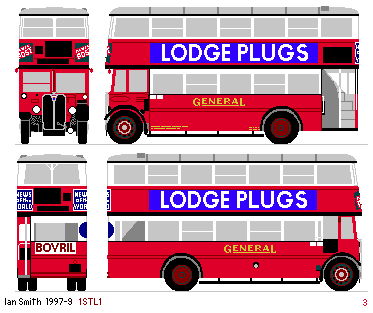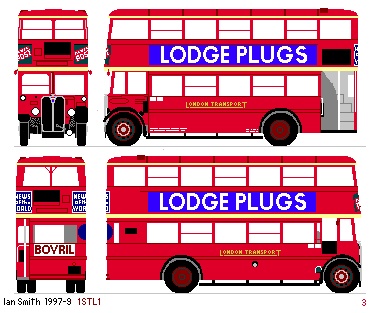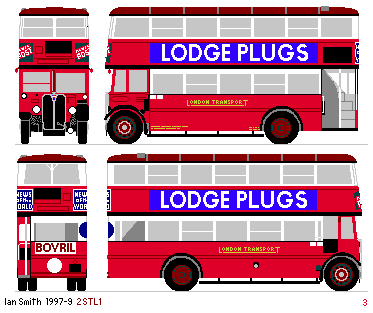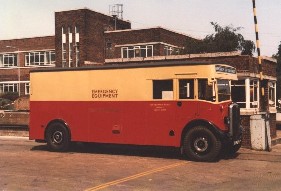
The GENERAL STLs
This page updated 1st June 2020
STL 1-50, (Total 50) 1STL1Introduced: January 1933.
Chassis, 1STL: AEC Regent , 16ft 3in wheel-base, petrol, crash gearboxes
Body, STL1: Chiswick: 60 seats (26 + 34).
General STL in pre-war livery.When new this first batch went to Clay Hall garage for service on the 8 and 160, but were replaced there for some arcane reason when the first batch of STL2s became available in the autumn of 1933. The 1STL1s went to Willesden (AC) for route 8 and Elmers End (ED) for the 12 group.
STL50 was fitted from new with a preselector gearbox. Although allocated new to Clay Hall along with STL1-49, it was probably not used there, but was quickly transferred to Plumstead which was used to such things with preselector LTs. The 1STL1s - as they were classified by LT in March 1934 did not stay at their initial allocations, of course, being gradually moved outwards towards the less-favoured parts of the system where petrol engined buses survived. During the war they received the usual amendments: restricted headlights, white spots on the back, anti-shatter mesh on the windows, restricted displays, and brown roofs. Several were destroyed by enemy action, especially in the bombing of Croydon garage in October 1941. Some surviving chassis were given "float bodies" and one was given a new chassis too, built from spares! A couple of bodies that were in the overhaul float also went onto new "unfrozen" chassis to create "new" buses. Some of the 1STL chassis also received later bodies during overhaul.
Some spent a little while as trainers, or in the Special Events fleet,
until such time as the Vehicle Inspectorate caught up with them.
So while many other STLs were polished up to survive through the Festival of Britain,
the "General" STLs were early victims of the RT family before 1950.
But that was not quite the end for some of them. Some of them spent a little while sitting under RT bodies. No! not as SRTs, but just supporting the spare RT bodies built for the works float, until such time as they were needed. Quite a few others were turned into service vehicles, usually with new cabs and bodywork by Kenex.
STL 153-202 (Total 50) 2STL1,Chassis: as STL 1-50 but with different exhaust layout and coil ignition.Body: as STL 1-50 and interchangeable (STL1). 3 spares. This batch was being delivered when the LPTB took over from LGOC in July 1933. Visually they looked just the same as the first STLs, but the chassis improvements kept them distinct in engineering terms. General STL in post-war livery, with war-restricted blind display.They appeared in 1930, twenty-five of them during the General era. These went into service at Hendon (AE), Middle Row (X) and Camberwell (Q) during the last ten days of June. The last fifteen went into service - for London Transport - at Elmers End garage (ED) at the start of August.
Their history parallelled that of the first batch. As garages became petrol or diesel-driven, so the batch wound up at the former: Croydon (TC), where so many were destroyed, Bromley (TB), Turnham Green (V) and Middle Row (X). Like the 1STL1s, they were early candidates for post-war withdrawal, and most disappeared during 1949.
Again, some reappeared with service vehicle bodies:
832J at Acton Underground Works Open Day 1983.
|



 bus histories
bus histories

 Ian's Bus Stop
Ian's Bus Stop STL contents
STL contents top of page
top of page